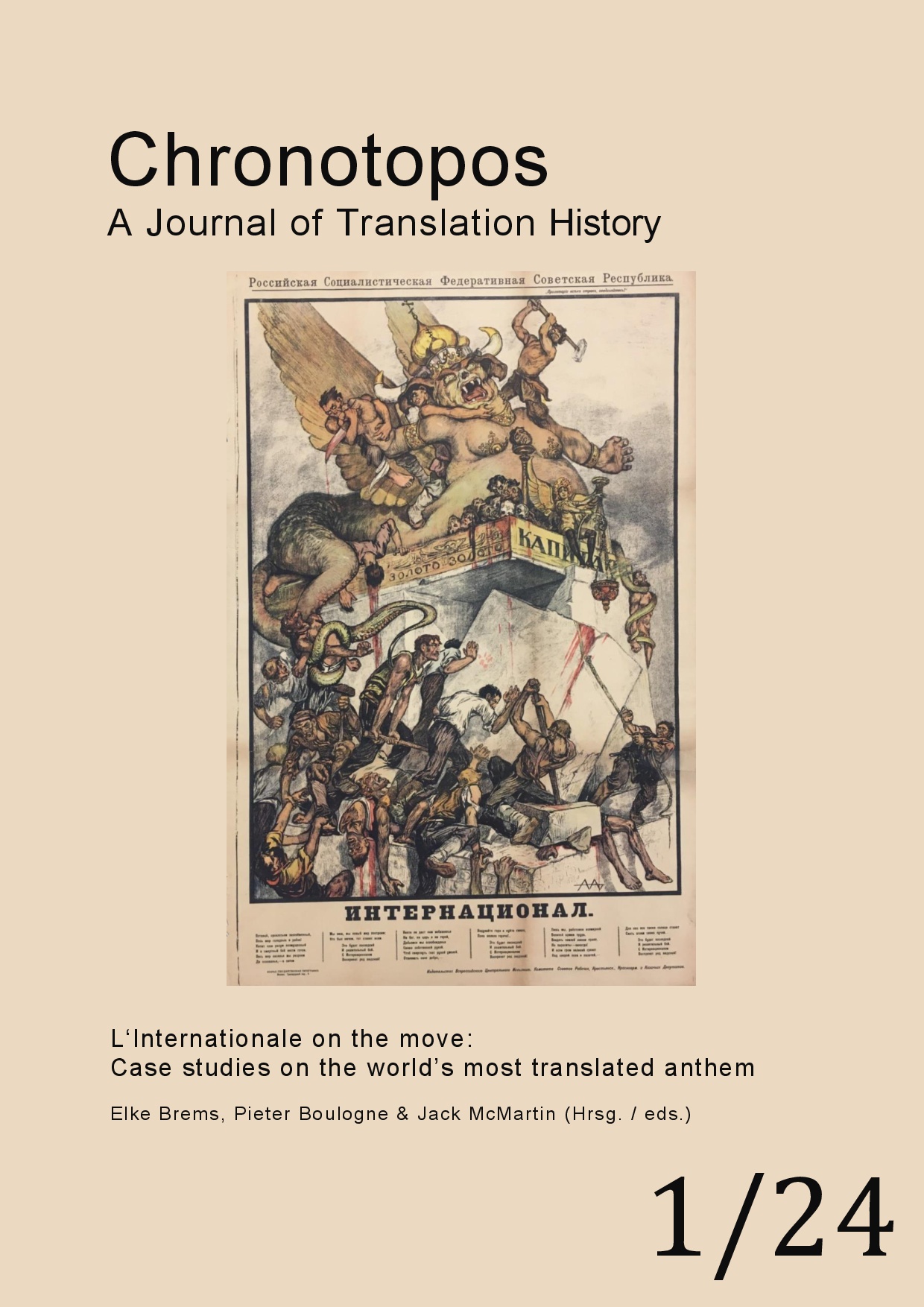“Translated by Arkadiy Kots”
Weaponization, Consecration, Monumentalization and Reincarnation of the Russian “Internationale”
DOI:
https://doi.org/10.70596/cts173Keywords:
Arkadiy Kots, The Internationale, rock band, translator, anthem, Soviet UnionAbstract
The impact of Arkadiy Kots as the translator of “L’Internationale” on Russian society is easy to underestimate. His Russian song translation, which emerged as a product of the counterculture, was first weaponized by Lenin to motivate workers to engage in the Russian Revolution. Then, it became the object of consecration: it was made the first anthem of the Soviet Union. However, with the passing of time, the song became an ideological and diplomatic issue, which under Stalin was solved by its monumentalization. As an established monument, Kots’s translation remained a fixture in Soviet culture until the very collapse of the empire. It is obvious that the failure of the Soviet experiment heavily damaged Kots’s cultural value. Nevertheless, his song translation remains present in post-Soviet Russia as the anthem of the Communist Party of the Russian Federation. At the same time, Kots also serves as an inspiration for the protest band that under his name has translated “L’Estaca”, which, as the most popular protest song of our time, could be seen as a reincarnation of “L’Internationale”.
References
AL’SHVANG, A. & TSUKERMAN, V. (1977): “Lyubimyye muzykal’nyye proizvedeniya V. I. Lenina”. In: ALEKSANDROV, A. & LEVIN, L. (eds.): Oktyabr’ i muzyka. Sbornik statey. Moscow: Muzyka., 234–253.
BAER, James Brian (2016): Translation and the Making of Russian Literature. New York/London: Bloomsbury.
BOURDIEU, Pierre (1993): The Field of Cultural Production: Essays on Art and Lit-erature. Cambridge: Polity Press/New York: Columbia University Press.
CHERNYAYEV, I. A. (2023): “Arkadiyy Kots – Zabytaya stranitsa prolelarskoy literatury”, Svoy variant. Sayt mezhdunarodnogo soyuza pisateley. https://mspru.org/literaved/24468-Arkadiyj-koc-zabytaja-stranica-proletarskoj-literatury.html
DREYDEN, Sim (1981): Muzyka – revolyutsii. Moscow: Sovetskiy kompozitor.
DREYDEN, Sim (1988): Pesn’ pesney revolyutsii. Stranitsy istorii “Internatsionala”. Moscow: Sovetskiy kompozitor.
DROBINSKIY, Al (1930): “Internatsional”. In: Literaturnaya entsiklopediya. V 11 t. [M.], 1929–1939. T. 4. [M.]: Izd-vo Kom. Akad., 540–546. http://feb-web.ru/feb/litenc/encyclop/le4/le4-5401.htm
DRUSKIN, Mihail S. (1959): Russkaya revolyutsionnaya pesnya. Leningrad: Gosudarstvennoye muzykal'noye izdatel'stvo.
FITZPATRICK, Sheila (1984): Cultural Revolution in Russia, 1928–1931. Bloomington: Indiana University Press.
GIBBONS, Christian & JÄRVINIEMI, Juuso (2020): “Crossing Europe, ‘L’Estaca’style: A Quick Guide to Europe’s Most Popular Protest Song”. Tourillon.org. https://www.taurillon.org/crossing-europe-l-estaca-style-a-quick-guide-to-europe-s-most-popular?lang=fr
GIELKENS, Jan (1998): “Hoe de Internationale haar wereldreis maakte”. In: SOUBRY, L. & VERMOTE, M. (eds.): Pierre De Geyter: het grote lied van een kleine man (1848–1932). Ghent: AMSAB, 70–88.
GIELKENS, Jan (1999): “Het heil’ge Ontwakingslied: ‘De Internationale’ vertaald”, Filter 6 (2), 32–43.
HERMISTON, Roger (2016): All Behind You, Winston: Churchill’s Great Coalition 1940–45. London: Aurum Press.
HOFFMANN, Dieter (2018): “L’estaca von Lluís Llach – eine katalische Freiheitshymne und ihre Varianten in anderen Sprachen. Teil 10 der musikalischen Sommerreise 2018”, Rotherbaron.com. https://rotherbaron.com/2018/08/18/lestaca-von-lluis-llach-eine-katalanische-freiheitshymne-und-ihre-varianten-in-anderen-sprachen/
JOVOVICH, Tat’jana (2021): “Vzryvnoy potentsial sovremennogo art-aktivizma: faktory – funktsii – retseptsiya”, Quaestio Rossica 9 (2), 471–486.
KARABANOV, Aleksey (2015): “Ot «Internatsionala» k gimnu SSSR”, Voprosy Teatra 3–4, 237–263. https://theatre.sias.ru/upload/voprosy_teatra/2015_3-4_237_263_karabanov.pdf
KHENTOVA, Sofiya M. (1986): Melodii velikogo vremeni. Moscow: Muzyka. http://www.norma40.ru/articles/internatsional-istoriya.htm
LIVSHITS, D. (2009): “Proshchaniye s «Internatsionalom»”, Ural 7. https://magazines.gorky.media/ural/2009/7/proshhanie-s-internaczionalom.html
MEYER, Justin (2023): “The Monumentalization of the Past: German Humanist Patriotism and Source Use, 1488–1582”, Arts & Sciences Electronic Theses and Dissertations 2893. https://openscholarship.wustl.edu/art_sci_etds/2893
MINER, Steven Merritt (2003): Stalin’s Holy War: Religion, Nationalism, and Alliance Politics, 1941–1945. Chapel Hill: University of North Carolina Press.
RAKOVSKIY, Khristian G. (1900): “Mezhdunarodnyy sotsialisticheskiy kongress v Parizhe”, Iskra 1, 23–25.
ROSSMAN, Jeffrey (2005): Worker Resistance under Stalin: Class and Revolution on the Shop Floor. Cambridge, MA: Harvard University Press.
SHAPOCHKIN, Dmitry V. (2013): “Kontseptual’noye protivostoyaniye «vlast’» vs «spravedlivost’» v tekste gimna ‘international’”, Politicheskaya lingvistika 44 (2), 132–136.
SHAPOCHKIN, Dmitry V. (2015): “Еtapy stanovleniya revolyutsionnogo gimna”, Vestnik Tyumenskogo gosudarstvennogo universiteta. Gumanitarnyye issledo-vaniya. Humanitates 1:4 (4), 159–166.
SHILOV, A. (1963): Iz istorii pervykh sovetskikh pesen (1917–1924). Moscow: So-vetskiy kompozitor.
SIBIRYAKOV, I. V. (2018): “Rol’ intelligenetsii v sokhranenii kul’turnoy pamyati sovetskogo sotsiuma o revolyutsii 1917 goda”, Intelligentsiya i mir 2, 9–20.
SIDOROVSKIY, Lev I. (1987): “Pochashche poyte pesni Revolyutsii ...” Leningrad: Sovetskiy kompozitor.
TITUS, Joan (2016): The Early Film Music of Dmitry Shostakovich. Oxford: Oxford University Press.
ZIPPERSTEIN, Steven (1985): The Jews of Odessa: A Cultural History, 1794–1881. Stanford, CA: Stanford University Press.
Downloads
Published
How to Cite
Issue
Section
License
Copyright (c) 2025 Pieter Boulogne

This work is licensed under a Creative Commons Attribution-NonCommercial 4.0 International License.


